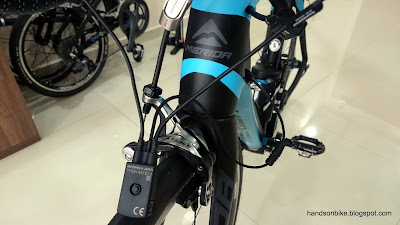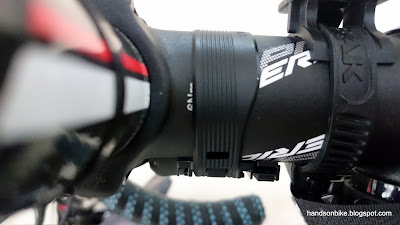This is a very unusual situation, as I always charge the Di2 battery once the battery level drops to 50% or less. Also, the Di2 battery is supposed to last a long time, even more so if you are not using it often. As I have been using Di2 since I upgraded the Dahon Boardwalk 3 years ago, I am well aware of the battery life of the system.
My first suspicion was that one of the shifter buttons had been depressed continuously during storage, as there was a chance that another of my bike could be pressing on the shifter buttons on the Merida road bike. However, upon charging up the battery to 100% and leaving it for a couple of days, the battery level dropped to 60% even without touching the bike.
The next suspicion was a faulty battery. This was a possibility as the battery was already 3 years old, and there was a chance that the battery life has been compromised. I swapped the battery with the other one on the Dahon MuEX, and monitored the battery level on both the bikes for a few days. With both batteries at 100%, we will see if it is the battery issue or some other problem.
The result was that the battery (from the Merida) remained at 100% on the Dahon MuEX, which ruled out a faulty battery. On the other hand, the battery (from the MuEX) that was installed on the Merida went down to 80% after just one day, without any usage. Further monitoring saw the battery level drop by about 20% every day.
With the battery level dropping rapidly, by around 20% a day, this was definitely not normal. Something was wrong with the system, but it is going to be tricky to diagnose the source of the problem. Most of the components are ported over from the Wheelsport Fantasy mini velo, and it had worked perfectly. The only differences are the wiring in between the components, as I have used different lengths of wires. For some unknown reason, there is a problem with the Di2 system on the Merida road bike that is causing serious battery drain.
Current Di2 wiring layout on the Merida road bike
In order to troubleshoot the battery draining issue, I had to isolate the components one by one to see which is the component causing the battery drain. The obvious place to start would be from the battery. Since I have already confirmed that the battery is working fine, the next component to test would be the battery mount.
I plugged the battery into the battery mount, and disconnected the battery mount from the rest of the system. Wait one day, reconnect the wiring, and check the battery level with the Garmin Edge 510. The good thing of having the Garmin to check the battery level is that it has a digital readout of the battery level, at every 10% intervals. This is more precise than having to read the blinking lights on Junction A to determine the approximate battery level.
No battery drainage detected with just the battery mount connected, so I continued by connecting more components to the battery (through the battery mount).
Connect battery mount to Junction B, disconnect all RD, FD and Junction A from Junction B. No battery drainage, so I moved on to connect just the FD, followed by just the RD, and so on until the entire system has been tested individually for battery drain.
This is very time consuming, as it takes one day to detect any battery drain, so testing the entire system component by component took more than one week.
I eventually found that there is battery drainage when Junction A is connected to the system, but the RD, FD and shifters are not connected. It seems that Junction A might be the one causing the problem. In order to test the hypothesis, I borrowed a new Junction A to swap with my current Junction A.
The new Junction A is the three port type, unlike the older Y-junction EW67 type that has two integrated wires for the shifters. With this new EW90 Junction A, there is a need for two separate wires to connect Junction A to the two Di2 shifters.
New 3 port Junction A, SM-EW90-A
With the new Junction A wired up, I monitored the Di2 system for a few days, and was glad to see that the battery is no longer draining fast. Under normal circumstances, the Di2 battery level can stay at 100% for at least a couple of weeks if it is not used. I did not wait that long, but the battery level did stay at 100% after a few days, which is much better than the 20% drain per day.
I was glad to see that the Di2 components are working fine, and that the problem was actually due to a faulty Junction A. Not sure why this problem will surface suddenly after working fine for these few years, but I am glad that this can be easily solved with a new Junction A.
After waiting for a few more days to confirm the diagnosis, I was sure that the old Junction A was the problematic component. With that, it is time to formally swap in the new Junction A onto the bike!
New 3 port Junction A with the mounting bracket and the rubber strap. This will normally be installed on the stem. 3 more wires are needed to connect Junction A to the two shifters.
Original Ultegra EW67 Junction A, with the two wires for the shifters built into it
3 port Junction A installed onto the Merida bike for testing and monitoring
Rubber strap with bracket mount installed on the stem. The rubber strap needs to be cut to the correct length.
Junction A clipped in under the stem. There is a charging port on this Junction A, but it only works if the new internal Di2 seat post battery is used.
Two wires lead to the two shifters, while the third wire leads to Junction B.
The other side of Junction A has the LED indicator lights, for indicating the derailleur adjustment mode or to indicate battery level.
Similar wire routing with the new Junction A, using the cable wrap to keep things neat and tidy
With the new Junction A, there is no longer any battery draining issue. The Di2 battery can last a really long time with some light usage. Glad to be able to find the source of the issue and solve it with a change of Junction A.










No comments:
Post a Comment
Every comment is moderated before publishing due to spam bots. If you don't see your comment yet, it is likely that it is currently being reviewed. Thank you for your patience!